Plica Syndrome
Introduction
Physical Therapy in Merrick and Amityville for Knee
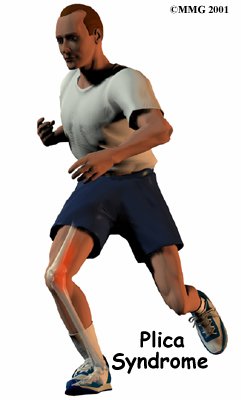
Welcome to Summit Physical Therapy's patient resource about Plica Syndrome.
Plica syndrome is an interesting problem that occurs when an otherwise normal structure in the knee becomes a source of knee pain due to injury or overuse. The diagnosis can sometimes be difficult, but if this is the source of your knee pain, it can be easily treated.
This article will help you better understand:
- what a plica is
- how plica syndrome can cause problems
- what doctors can do to treat the condition
Anatomy
What is a plica, and what does it do?
Plica is a term used to describe a fold in the lining of the knee joint. Imagine the inner lining of the knee joint as nothing more than a sleeve of tissue. This sleeve of tissue is made up of synovial tissue, a thin, slippery material that lines all joints. Just as a tailor leaves extra folds of material at the back of sleeves on a shirt to allow for unrestricted motion of the arms, the synovial sleeve of tissue has folds of material that allow movement of the bones of the joint without restriction.
Four plica synovial folds are found in the knee, but only one seems to cause trouble. This structure is called the medial plica. The medial plica attaches to the lower end of the patella (kneecap) and runs sideways to attach to the lower end of the thighbone at the side of the knee joint closest to the other knee. Most of us (50 to 70 percent) have a medial plica, and it doesn't cause any problems.
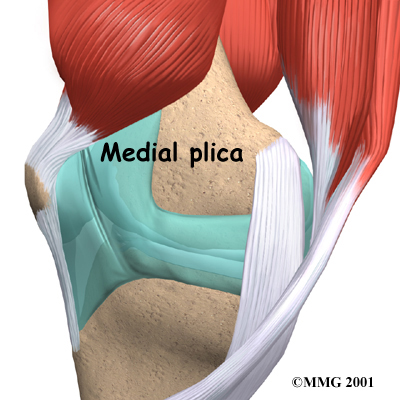
Related Document: Summit Physical Therapy's Guide to Knee Anatomy
Causes
How does a plica cause problems in the knee?
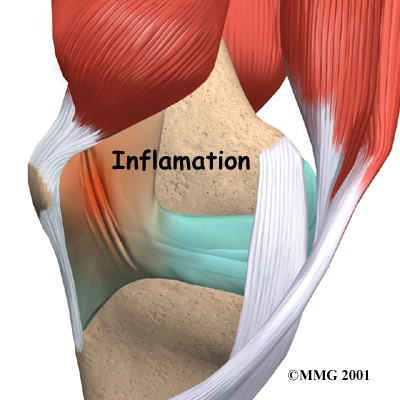 A plica causes problems when it is irritated. This can occur over a long period of time, such as when the plica is irritated by certain exercises, repetitive motions, or kneeling.
A plica causes problems when it is irritated. This can occur over a long period of time, such as when the plica is irritated by certain exercises, repetitive motions, or kneeling.
Activities that repeatedly bend and straighten the knee, such as running, biking, or use of a stair-climbing machine, can irritate the medial plica and cause plica syndrome.
Injury to the plica can also happen suddenly, such as when the knee is struck in the area around the medial plica.
This can occur from a fall or even from hitting the knee on the dashboard during an automobile accident.
This injury to the knee can cause the plica, and the synovial tissue around the plica, to swell and become painful.
The initial injury may lead to scarring and thickening of the plica tissue later.
The thickened, scarred plica fold may be more likely to cause problems later.
Symptoms
What does plica syndrome feel like?
The primary symptom caused by plica syndrome is pain. There may also be a snapping sensation along the inside of the knee as the knee is bent. This is due to the rubbing of the thickened plica over the round edge of the thighbone where it enters the joint. This usually causes the plica to be tender to the touch. In thin people, the tissue that forms the plica may be actually be felt as a tender band underneath the skin. In rare cases where the plica has become severely irritated, the knee may become swollen.
Snapping Sensation
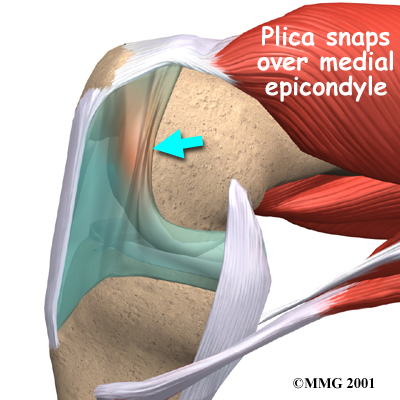
Diagnosis
When you visit Summit Physical Therapy, we will begin your diagnosis with a history and physical exam. The examination is used to try and determine where the pain is located and whether or not the band of tissue can be felt.
Some patients may be referred to a doctor for further diagnosis. Once your diagnostic examination is complete, the Physical Therapists at Summit Physical Therapy have treatment options that will help speed your recovery, so that you can more quickly return to your active lifestyle.
Our Treatment
What can be done for plica syndrome?
The majority of people with plica syndrome will get better without surgery. The primary goal when treating the plica is to reduce the inflammation. This may require limiting activities like running, biking, or using a stair-climbing machine.
Non-surgical Rehabilitation
When you begin Physical Therapy at Summit Physical Therapy, we may first suggest anti-inflammatory medications such as ibuprofen or aspirin to reduce the inflammation. Our Physical Therapist may also use ice packs or ice massage to help reduce the inflammation and swelling in the area of the plica. Ice massage is easy and effective. Simply freeze water in a paper cup. When needed, tear off the top inch, exposing the ice. Rub three to five minutes around the sore area until it feels numb.
Additionally, we may apply treatments such as ultrasound and friction massage to calm inflammation in the plica. Our therapy sessions sometimes include iontophoresis, which uses a mild electrical current to push anti-inflammatory medicine to the sore area. This treatment is especially helpful for patients who can't tolerate injections.
Once the inflammation is reduced, our Physical Therapist will begin treatments involving stretching and strengthening exercises for the leg.
Although the time required for recovery varies, if your treatment is nonsurgical, you should be able to return to normal activity within four to six weeks.
Post-surgical Rehabilitation
When you begin post-surgical Physical Therapy, our first few rehabilitation sessions will be designed to ease pain and swelling and help you begin gentle knee motion and thigh tightening exercises. Patients rarely need to use crutches after this kind of surgery.
As our program evolves, our therapist will choose more challenging exercises. Patients do closed chain exercises by keeping their foot on a surface while working the knee joint. These exercises mimic familiar activities like squatting down, lunging forward, and going up or down steps. These exercises help keep pressure off the kneecap while getting a challenging workout for the leg muscles. Our Physical Therapist will work with you to make sure you are not having extra pain in your knee during the exercises. We may also have you do stretches for the soft tissues along the edge of the kneecap as well as flexibility exercises for the hamstrings, quadriceps, and calf muscles.
At Summit Physical Therapy, our goal is to help you keep your pain under control, increase the strength of your quadriceps muscles, and maximize the range of motion in your knee. When your recovery is well under way, regular visits to our office will end. Although we will continue to be a resource, you will be in charge of doing your exercises as part of an ongoing home program.
Summit Physical Therapy provides services for Physical Therapy in Merrick and Amityville.
Surgery
If all nonsurgical attempts to reduce your symptoms fail, surgery may be suggested. Usually, an arthroscope (mentioned earlier) is used to remove the plica. The small TV camera is inserted into the knee joint through one-quarter inch incisions. Once the plica is located with the arthroscope, small instruments are inserted through another one-quarter inch incision to cut away the plica tissue and remove the structure. The area where the plica is removed heals back with scar tissue. There are no known problems associated with not having a plica, so you won't miss it.
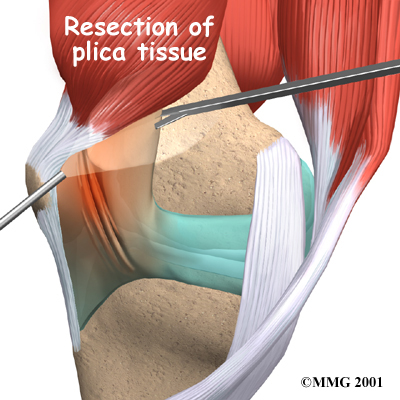
Portions of this document copyright MMG, LLC.

